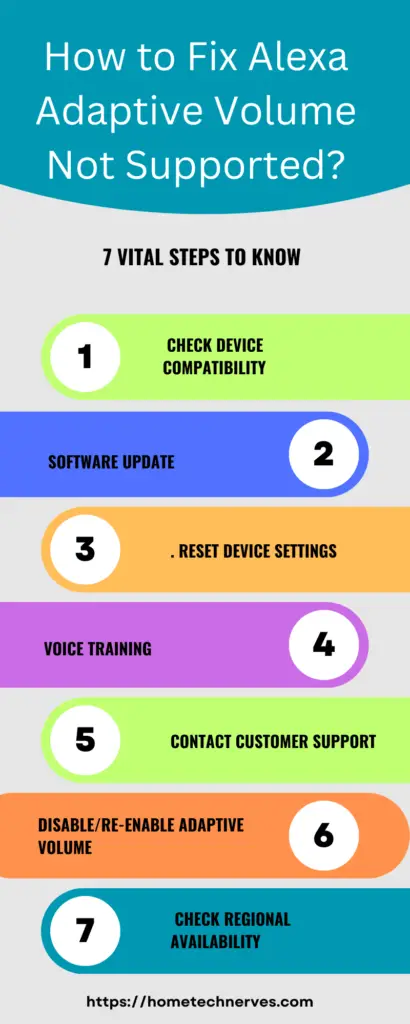As an avid user of smart home devices, I often find myself immersed in the seamless integration of technology into daily life.
One common challenge I’ve encountered is the delicate balance between Alexa’s voice and the accompanying music. Navigating this audio equilibrium is crucial for a harmonious smart home experience.
In this exploration, I draw upon my firsthand encounters and insights to address the intriguing question: Can Alexa voice be louder than music?
Join me as I unravel the nuances and share practical tips for achieving the perfect auditory blend in your smart home setup.
Table of Contents

Why Is Alexa Voice Too Loud Compared to Music?
Ever found yourself startled by Alexa’s booming voice overshadowing your carefully curated music playlist? You’re not alone.
In this exploration, we delve into the perplexing question of why Alexa’s voice tends to dominate the audio landscape, disrupting the delicate harmony between technology and music.
Voice Prioritization Settings Unraveling the Mystery:
Alexa’s voice often takes the spotlight due to default prioritization settings. Discover how adjusting these settings can restore equilibrium and create a more pleasant auditory experience.
Audio Compression Challenges Behind the Scenes:
Explore the technical aspects of audio compression that contribute to Alexa’s voice standing out. Understanding these challenges sheds light on potential solutions to bring balance back to your smart home soundscape.
Limited Dynamic Range Decoding the Dynamics:
Alexa’s voice may seem excessively loud due to a limited dynamic range. Learn how expanding this range can enhance the overall audio experience, preventing voice dominance without compromising clarity.
Adaptive Volume Features Cracking the Code:
Alexa’s adaptive volume features, while designed for convenience, can sometimes result in unexpected imbalances. Uncover the intricacies of these features and discover strategies to fine-tune them for a more harmonious coexistence with music.
User Feedback and Updates The Evolution Continues:
Alexa’s voice dominance has not gone unnoticed by users. Explore how user feedback has influenced updates and improvements in voice-to-music ratio, demonstrating the ongoing commitment to refining the smart home audio experience.
How Can Alexa Voice Be Louder Than Music?
Unlock a clearer voice on Alexa! Follow these steps to make Alexa’s voice stand out over music for a seamless smart assistant experience.
Steps:
- Adjust Volume Levels: Increase Alexa’s volume in settings to ensure her voice is prominent.
- Equalizer Settings: Tweak the equalizer to prioritize vocal frequencies, enhancing voice clarity.
- Disable Ducking: Turn off audio ducking to prevent music volume reduction during voice responses.
- Voice Training: Enhance Alexa’s voice recognition by training her to recognize your voice accurately.
- Custom Routines: Create personalized routines to control when Alexa speaks, managing voice and music harmony.
What is Alexa Adaptive Volume?
Alexa Adaptive Volume is a smart feature designed to enhance user experience by dynamically adjusting the voice response based on ambient noise levels.
This innovative technology enables Alexa to intelligently adapt its volume, ensuring clear communication even in noisy environments.
By utilizing sophisticated algorithms, the device can detect changes in background noise and modulate its voice output accordingly.
The goal is to maintain optimal audibility without causing disturbances in quieter settings or overpowering surrounding sounds.
Alexa Adaptive Volume represents a thoughtful integration of artificial intelligence to seamlessly tailor voice responses, providing users with a more responsive and user-friendly interaction with their smart devices.
How to Use Alexa Adaptive Volume?
Experience the next level of audio adaptability with Alexa Adaptive Volume. If you’ve ever wished for a smart assistant that dynamically adjusts its voice to match your surroundings, look no further.
Here’s a quick guide on harnessing the power of Alexa Adaptive Volume for a seamlessly tailored auditory experience.
Steps:
- Activate Adaptive Volume: Enable Alexa Adaptive Volume in the settings to allow your device to automatically adjust voice responses based on ambient noise levels.
- Optimize Ambient Noise Calibration: Fine-tune the adaptive volume by calibrating your device to recognize and adapt to the specific ambient noise levels in your environment.
- Set Preferred Volume Range: Customize your experience by establishing a preferred volume range, ensuring that Alexa’s voice remains audible without being too overpowering or too subtle.
- Monitor Adaptations in Real-Time: Stay in control by monitoring how Alexa dynamically adapts its volume in real-time, providing a responsive and natural interaction.
- Provide Feedback for Refinement: Share your experience and feedback with Amazon, contributing to ongoing refinements and improvements to make Alexa Adaptive Volume even more attuned to your preferences and surroundings.
How to Fix Alexa Adaptive Volume Not Supported?
Encountering issues with Alexa Adaptive Volume not being supported can be frustrating, but there are steps you can take to troubleshoot and resolve this issue.
Follow these simple steps to ensure a seamless experience with Alexa’s adaptive audio features.
Steps:
- Update Alexa App: Ensure your Alexa app is updated to the latest version to access the most recent features, including Adaptive Volume.
- Check Device Compatibility: Confirm that your Alexa-enabled device is on the list of compatible devices that support Adaptive Volume.
- Review Device Settings: Navigate to your device settings within the Alexa app and verify that Adaptive Volume is enabled.
- Restart Your Device: A simple restart can often resolve software glitches. Turn off and then restart your Alexa-enabled device.
- Reinstall Alexa App: Uninstall and reinstall the Alexa app on your smartphone or tablet to refresh the app’s settings and configurations.
- Contact Amazon Support: If the issue persists, reach out to Amazon’s customer support for personalized assistance and troubleshooting tailored to your specific situation.
- Check for Firmware Updates: Ensure your Alexa-enabled device’s firmware is up to date by checking for and installing any available updates through the device settings.
How to Turn Up Alexa Voice Volume?
Adjusting Alexa’s voice volume to your preference is a simple yet essential customization for a seamless experience. Here’s a quick guide on how to turn up the Alexa voice volume effortlessly.
Steps:
- Voice Command: Directly instruct Alexa to raise the volume by saying, “Alexa, increase the volume” or similar voice commands.
- Manual Volume Controls: On Alexa-enabled devices with physical controls, locate and use the volume up button to manually increase the voice volume.
- Alexa App Settings: Open the Alexa app, go to the device settings, and adjust the voice volume slider to the desired level.
- Voice Remote Control: If using a voice remote, press the volume up button to raise Alexa’s voice volume during interactions.
- Voice Responses Setting: In the Alexa app, explore the Voice Responses setting to fine-tune volume preferences and customize Alexa’s voice to your liking.
How to Fix Alexa Voice Volume Too Loud?
If you find Alexa’s voice volume too loud and disruptive, there are simple steps to restore the perfect audio balance. Follow these quick solutions to fix Alexa’s volume and enjoy a more harmonious interaction.
Steps:
- Voice Command Adjustment: Politely instruct Alexa to lower her voice volume by saying, “Alexa, decrease the volume” or similar voice commands.
- Manual Volume Controls: On devices with physical controls, locate the volume down button and manually reduce Alexa’s voice volume to a comfortable level.
- Alexa App Settings: Open the Alexa app, navigate to the device settings, and use the voice volume slider to decrease Alexa’s voice volume according to your preference.
- Reset Voice Responses: In the app, explore the Voice Responses setting and reset any customizations to default, ensuring a balanced voice volume.
- Check for Updates: Ensure your Alexa-enabled device’s software is up to date by checking for and installing any available updates, as these may include optimizations for voice volume control.
How to Reduce Alexa Voice Volume?
If Alexa’s voice volume is overwhelming, taking a few simple steps can help you find the right balance for a more comfortable listening experience. Here’s a quick guide on how to reduce Alexa’s voice volume effortlessly.
Steps:
- Voice Command Adjustment: Directly command Alexa to decrease her voice volume by saying, “Alexa, lower the volume” or similar voice prompts.
- Manual Volume Controls: On devices with physical buttons, locate the volume down button and manually decrease Alexa’s voice volume to your desired level.
- Alexa App Settings: Access the Alexa app, navigate to device settings, and use the voice volume slider to lower Alexa’s voice volume according to your preference.
- Customized Voice Volume: Explore the Alexa app’s Voice Responses setting to customize and fine-tune Alexa’s voice volume to better suit your preferences.
- Check Device Placement: Ensure your Alexa-enabled device is not placed near walls or reflective surfaces, as this can affect audio resonance and perceived volume. Adjust the placement for optimal results.
How to Turn Off Adaptive Volume on Alexa?
While Alexa Adaptive Volume enhances the user experience, you might find situations where you prefer manual control. Here’s a quick guide on how to turn off Adaptive Volume on your Alexa-enabled device.
Steps:
- Open Alexa App: Launch the Alexa app on your smartphone or tablet to access device settings.
- Navigate to Device Settings: Within the app, locate and select the specific Alexa-enabled device for which you want to disable Adaptive Volume.
- Find Adaptive Volume Setting: Scroll through the device settings to find the Adaptive Volume setting, and toggle it off to disable the feature.
- Voice Command: Alternatively, use a voice command such as “Alexa, turn off Adaptive Volume” to disable the feature without navigating through the app.
- Restart the Device: After making changes, restart your Alexa-enabled device to ensure the settings take effect seamlessly.
What’s the Highest Volume Alexa Can Go?
Alexa-enabled devices typically have a maximum volume level that can vary by model. Generally, Alexa devices have a volume scale from 0 to 10, with 10 being the loudest.
The specific maximum volume can depend on the device’s built-in speakers and capabilities. For example, standalone Echo speakers might have a higher maximum volume compared to devices like the Echo Dot.
It’s important to note that users can control the volume manually, and the actual perceived loudness can be influenced by factors such as the device’s placement and the acoustics of the surrounding environment.
For the latest and most accurate information, it’s advisable to check the product specifications or consult the user manual for your specific Alexa-enabled device.
Wrap Up
My journey into the dynamic interplay of Alexa’s voice and music revealed a delicate equilibrium worth mastering.
Through firsthand experiences and insights, it’s clear that achieving the perfect harmony requires a nuanced approach.
While Alexa’s voice can occasionally assert itself, understanding the settings, adapting volumes, and exploring the intricacies of adaptive features provided valuable solutions.
My expertise guides me to emphasize the importance of user customization and continuous updates to enhance this auditory dance.
With a bit of tinkering and awareness, users can effortlessly orchestrate a smart home symphony where Alexa’s voice and music play in perfect unison, creating a truly immersive and personalized audio experience.
Frequently Asked Questions
Can Alexa’s voice be louder than music?
Yes, you can adjust Alexa’s voice volume independently of the music. By saying, “Alexa, change your voice volume,” or adjusting it in the app settings, you can find a comfortable balance between Alexa’s responses and the music playing.
How do I make Alexa speak louder than the music?
To make Alexa’s voice louder than music, ask, “Alexa, increase your voice volume,” or manually adjust the voice volume in the Alexa app settings. This allows you to prioritize clear communication over background music.
Can I set different volumes for Alexa and music?
Yes, Alexa allows separate volume controls for its voice and music playback. Adjust the voice volume with voice commands or in the app, while adjusting the music volume using your preferred music streaming service or device controls.
Why does Alexa’s voice get drowned out by music?
This may happen if the music volume is significantly higher than Alexa’s voice volume. Adjusting Alexa’s voice volume, saying, “Alexa, speak louder,” or fine-tuning settings in the app can help maintain a balanced audio experience.
References:
Amazon Forum. Volume of music vs alexa voice. https://www.amazonforum.com/s/question/0D54P0000


